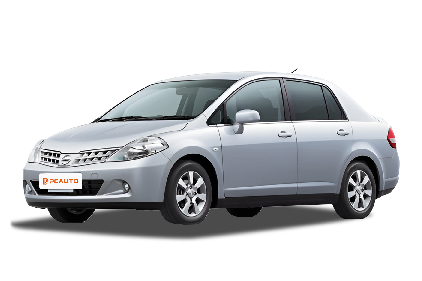Q
Is the Nissan Latio a good car?
The Nissan Latio is a popular economy sedan in the Malaysian market, suitable for daily commuting and family use. Its advantages include fuel efficiency, spacious interior, and relatively low maintenance costs. The 1.6L or 1.8L engine it's equipped with offers smooth power output, making it ideal for city driving. The CVT transmission also enhances fuel economy. The interior design is simple and practical, the seats are quite comfortable, and the trunk space is sufficient to meet the needs of an average family.
However, its handling performance is just average, so it's not suitable for users who pursue driving pleasure. Also, its sound insulation is not outstanding among vehicles in the same class. In Malaysia, the Latio has a decent resale value for used cars, with an abundant supply of parts and convenient maintenance, making it a cost - effective choice.
If you need a reliable and hassle - free commuter car, the Latio is worth considering. But if you have higher requirements for technological features or driving experience, you may need to compare other models in the same class. Given Malaysia's hot and rainy climate, it's recommended to regularly check the air - conditioning system and the anti - rust condition of the chassis to extend the vehicle's lifespan.
Special Disclaimer: This content is published by users and does not represent the views or position of PCauto.
Related Q&A
Q
What is another name for the Nissan latio?
In the Malaysian market, the Nissan Latio is also known as the Nissan Sylphy. This model is a compact sedan launched by Nissan for the Asian market, focusing on comfort and fuel economy. The Nissan Latio/Sylphy is quite popular in Malaysia. Its spacious interior and reliable performance make it a popular choice for family cars. This model is equipped with a 1.6L or 1.8L naturally aspirated engine, paired with a CVT transmission, providing a smooth driving experience. In addition, the Nissan Latio/Sylphy is also equipped with a number of practical features, such as a smart key system, automatic air - conditioning, and a rear - view camera, which further enhance driving convenience. For Malaysian consumers, the Nissan Latio/Sylphy is not only an affordable daily commuter but also meets the needs of long - distance travel. It is a highly cost - effective model.
Q
Where is Latio from?
The Latio is a compact sedan under Nissan. Initially designed and produced by the Japanese automaker Nissan Motor Company, it's mainly targeted at the Asian market, including Malaysia. This car was once popular in the Malaysian market for its affordability, high fuel efficiency, and strong reliability, making it suitable for city driving and family use.
The Malaysian version of the Latio is typically equipped with a 1.6L or 1.8L engine, offering a comfortable riding experience and a practical interior design. For Malaysian consumers, the Latio is a cost - effective choice, especially for daily commuting and family outings.
As a globally well - known automotive brand, Nissan has an extensive sales and service network in Malaysia, providing reliable after - sales support for car owners. Moreover, the used - car market performance of the Latio is relatively stable, with a high resale value, which further enhances its appeal in the Malaysian market.
If you're thinking about buying an economical and practical used car, the Latio is a worthy option. However, it's advisable to conduct a detailed inspection of the vehicle's condition before purchase and choose a dealer or seller with a good reputation.
Q
How much fuel does a Nissan latio use per 100km?
The fuel consumption of the Nissan Latio varies depending on the model and driving conditions. According to official data and user feedback, its combined fuel consumption is approximately 6 to 7 liters per 100 kilometers. The specific figure is affected by driving habits, road conditions, and vehicle maintenance. For instance, the fuel consumption may be slightly higher in congested urban areas, while it's more fuel - efficient during highway cruising.
For Malaysian consumers, as an economical and practical family sedan, the Latio has a relatively balanced fuel efficiency among vehicles in the same class, making it suitable for daily commuting and family use. To further reduce fuel consumption, it's recommended to have the vehicle regularly maintained, keep the tire pressure normal, and avoid bad driving habits such as sudden acceleration and hard braking.
Moreover, the fuel prices in Malaysia often fluctuate due to government subsidies. Choosing a fuel - efficient model can effectively reduce long - term vehicle usage costs, and the Latio's fuel consumption performance has certain advantages in this regard.
Q
Is Nissan Latio the same as Nissan Tiida?
The Nissan Latio and Nissan Tiida are actually the same model with different names in different markets. In the Malaysian market, Latio was the early name for Tiida. Later, as the model was updated, the name was gradually unified to Tiida. These two cars share the same platform and core technologies, including the engine, transmission, and chassis design. The main differences lie in the exterior details and configuration options. For example, the Latio may focus more on comfort features, while the Tiida leans towards a sportier design. For Malaysian consumers, whether it's the Latio or Tiida, they both inherit the consistent reliability and fuel efficiency of Nissan models, making them suitable for daily family use. It's worth mentioning that the Tiida is sold in multiple markets around the world, but the configuration and tuning will be adjusted according to local needs. For instance, the Malaysian version of the Tiida may place more emphasis on durability in tropical climates. If you're considering buying this car, it's recommended to test - drive the latest Tiida at a local Nissan dealership to experience its actual performance.
Q
How much torque does a Nissan latio have?
The torque output of the Nissan Latio depends on the specific model and engine configuration. Take the commonly - seen 1.6 - liter HR16DE four - cylinder naturally aspirated engine in the Malaysian market as an example. Its maximum torque is approximately 153 Newton - meters (Nm), and the peak torque is usually reached at around 4000 rpm. It is paired with a 4 - speed automatic or 5 - speed manual transmission, which meets the needs of city driving. If it is the version with a 1.8 - liter MR18DE engine (such as the Latio Sport), the torque can be increased to 174 Newton - meters, offering more powerful performance.
Torque is a key indicator for measuring the rotational force of an engine. A higher torque value means stronger traction during acceleration or climbing. However, the actual driving experience needs to be comprehensively judged in combination with horsepower, vehicle weight, and gearbox tuning. In Malaysia's hilly and congested road conditions, the Latio's linear torque output can balance fuel economy and smoothness, making it practical enough for daily commuting.
It is recommended that car owners conduct regular maintenance to ensure the engine's efficiency. At the same time, choose the appropriate oil viscosity (such as 5W - 30) to maintain the best torque performance.
Q
How much horsepower does the Nissan Latio engine have?
The Nissan Latio available in the Malaysian market is equipped with a 1.6-liter HR16DE naturally aspirated engine. It boasts a maximum horsepower of around 110 PS and a torque of 153 Nm. This engine is well - known for its durability and fuel economy, making it a great fit for city driving.
As an economical family car, the Latio's power performance is more than enough to meet the daily commuting needs. Meanwhile, it maintains a relatively low fuel consumption level, which aligns with the Malaysian consumers' emphasis on practicality and cost - effectiveness. If you have higher power requirements, you may consider the turbocharged versions of other models in the same class. However, the Latio shines with its low maintenance cost and high reliability, which are the very reasons why many Malaysian families opt for it.
In terms of engine technology, the HR16DE adopts the Continuously Variable Valve Timing Control (CVTC) technology, which optimizes power output and fuel efficiency. This kind of technology is quite common in modern small cars and can strike a balance between performance and environmental protection needs.
Q
How many cc is a Nissan Latio?
In the Malaysian market, the Nissan Latio mainly offers two engine displacement options, namely 1.6 liters and 1.8 liters, with the corresponding specific cc figures being 1598cc and 1797cc. Both of these two engines feature a four - cylinder design, which is suitable for daily city driving and family use, boasting good fuel economy and reliability. As a popular compact sedan, the Nissan Latio has won the favor of many consumers in the Malaysian market with its comfortable riding experience and practical space design. For readers who want to learn more about automotive knowledge, cc (cubic centimeters) is an important indicator for measuring engine displacement. Generally, the larger the displacement, the stronger the power output, but the fuel consumption may also increase accordingly. Therefore, when choosing a vehicle, one needs to comprehensively consider personal needs and budget. The Nissan Latio has mature engine technology and relatively low maintenance costs. It is suitable for the road conditions and climate in Malaysia, making it a cost - effective choice for a family sedan.
Q
Is the Nissan Latio a fuel saver?
The Nissan Latio performs well in terms of fuel economy and is especially suitable for the urban driving environment in Malaysia. The 1.6L and 1.8L engines it is equipped with adopt Nissan's fuel - saving technologies, such as the CVT transmission and the intelligent fuel management system, which can effectively reduce fuel consumption. Official data shows that its combined fuel consumption is about 6 - 7L per 100km, which is a fuel - efficient option for daily commuting or family use.
In addition, Latio's lightweight body design and low drag coefficient also contribute to improving fuel efficiency. However, the actual fuel consumption will still be affected by driving habits, road conditions, and maintenance status. If you focus more on fuel - saving, you can consider regularly maintaining the tire pressure and avoiding sudden acceleration and hard braking. These habits can further optimize the fuel consumption performance.
Among vehicles in the same class, Latio's fuel economy is in the upper - middle level. Although it may not be as fuel - efficient as some hybrid models, it is still a good choice for users with limited budgets who need a reliable commuter car.
Q
What type of engine is in a Nissan Latio?
In the Malaysian market, the Nissan Latio is primarily equipped with a 1.6-liter HR16DE four-cylinder naturally aspirated engine. This engine features a double overhead camshaft (DOHC) design and a continuous variable valve timing control system (CVTC). These advanced technologies enable it to deliver a smooth power output and excellent fuel economy. With a maximum power of approximately 110 horsepower and a peak torque of around 153 Nm, the engine is well - suited for city driving and daily commuting.
The HR16DE engine has gained wide recognition in the Malaysian market for its reliability and low maintenance costs. It offers two transmission options: a 4 - speed automatic transmission or a 5 - speed manual transmission, catering to different driving preferences.
Digging a bit deeper, the technical features of the HR16DE engine are also evident in its lightweight design and low - friction internal components. These characteristics contribute to reduced fuel consumption and an extended engine lifespan. For Malaysian consumers, the stability of the engine in hot climates and its performance under air - conditioning loads are of particular importance. The engine of the Nissan Latio has been tuned to take into account the usage conditions in tropical regions, resulting in a well - balanced overall performance.
Q
Is Nissan Latio a CVT?
Yes, the Nissan Latio is indeed equipped with CVT (Continuously Variable Transmission) technology. Especially in models produced between 2004 and 2012, CVT was one of its main transmission options. This design aims to provide a smoother driving experience and better fuel economy, which is very suitable for the stop - and - go driving environment on Malaysian city roads.
Unlike traditional automatic transmissions, CVT achieves continuously variable speed through a steel belt and pulley system, avoiding the jerks during gear shifts. At the same time, it can more efficiently match the engine speed with the vehicle speed, reducing fuel consumption. For Malaysian consumers, when maintaining a CVT, it is necessary to pay attention to regularly replacing the special transmission fluid to ensure its long - term reliability.
Nissan's application of CVT technology in models like the Latio demonstrates the maturity of its powertrain. Similar technologies are also widely used in some models of other Japanese brands such as Toyota and Honda, making it one of the mainstream choices for economical family cars.
Latest Q&A
Q
How big is Myvi fuel tank?
As one of the most popular national cars in Malaysia, the fuel tank capacity of the Perodua Myvi varies according to different generations and versions. The standard fuel tank capacity of the current third - generation Myvi (from 2017 to present) is 36 liters. It features a lightweight resin fuel tank design, which balances the fuel storage needs and the vehicle's body weight.
The fuel tank size of this B - segment model matches the fuel economy of its 1.3L/1.5L engines. It can provide a cruising range of approximately 450 - 550 kilometers under combined driving conditions, making it suitable for urban commuting and short - distance trips. It's worth noting that the actual available fuel tank capacity might be slightly less than the nominal value. This is because about 5% of the tank space is reserved for fuel expansion as a safety measure.
For owners planning long - distance drives, it is recommended to use the fuel efficiency display function on the Myvi's dashboard to monitor fuel consumption in real - time. Also, it's advisable to develop the habit of refueling when the fuel gauge shows that there is about 1/4 of the fuel left. This can prevent the fuel pump from overheating and also help deal with the situation where gas stations are far apart in some remote areas of Malaysia.
Some comparable models in the same segment, like the Proton Iriz, have a 40 - liter fuel tank. However, the actual cruising range needs to be considered in combination with the engine efficiency. Thanks to Perodua's mature powertrain tuning, the Myvi always maintains a competitive edge in terms of fuel economy.
Q
Does Myvi use CVT?
Yes, the Perodua Myvi does use CVT (Continuously Variable Transmission) technology in some models, especially the newer ones. For instance, the third-generation Myvi, launched in 2017, and its subsequent versions are equipped with D-CVT (Dual Mode Continuously Variable Transmission) to offer a smoother driving experience and better fuel efficiency. CVT technology optimizes engine performance through continuously variable gear ratios. Compared with traditional automatic transmissions, it can adapt to driving conditions more flexibly, thereby enhancing overall driving comfort. However, earlier Myvi models may have used a traditional 4-speed automatic transmission. So, whether a specific model is equipped with a CVT needs to be confirmed based on the model year and configuration. For Malaysian consumers, the advantages of CVT lie in its smoothness and fuel - saving performance during city driving, which is very suitable for the common local traffic conditions. But if you're looking for more direct power feedback, some drivers may prefer the manual transmission version. If you're considering buying a Myvi, it's recommended to check the official specifications or consult a dealer to confirm the transmission type. You can also take a test drive to see if the actual performance of the CVT meets your driving preferences.
Q
What kind of gearbox is Myvi?
The Myvi is equipped with a Dual Mode CVT (D-CVT) transmission, which is a dual-mode continuously variable transmission. Compared with traditional CVT transmissions, it has an additional gear for high-speed driving, which helps the vehicle achieve better fuel efficiency.
In daily driving, this transmission drives the vehicle in CVT mode. Thanks to the operation of the steel belt, the vehicle moves smoothly and linearly, enhancing comfort. What makes the D-CVT special is that it automatically switches to the gear mode when driving at high speeds. Different from CVT transmissions of other brands, when driving at high speeds, the engine speed of vehicles with ordinary CVT transmissions will increase, the engine noise will get louder, and the fuel consumption will rise. Moreover, the power will decline after exceeding the maximum horsepower speed. However, after the gear of the D-CVT engages, the engine speed decreases, allowing the engine to maintain a reasonable speed and providing the vehicle with continuous and abundant power.
Q
Are Myvi and vios the same engine?
Some models of the Myvi and the Vios use the same engine. Daihatsu and Perodua have a joint - venture engine production plant in Negeri Sembilan, Malaysia, which provides power for multiple models including the Vios. Some models of the Vios and the Myvi are equipped with the 1.5L Dual VVT - i engine. This engine features high efficiency, reliability, and economy. Although its power is not extremely strong (the official 0 - 100km/h acceleration time of the Myvi 1.5 is 10.2 seconds), its low fuel consumption and durability are well - loved by consumers. However, these two cars have different positioning and market targets. Even if they share the engine platform, there are differences in vehicle tuning, configuration, and the overall driving experience.
Q
How many cylinders are in the MYVI?
As one of the most popular national cars in Malaysia, the engine configurations of the Perodua Myvi vary according to different years and versions. Currently, the mainstream models are equipped with two types of Dual VVT - i four - cylinder naturally aspirated engines, namely the 1.3L (1NR - VE) and 1.5L (2NR - VE). Therefore, all Myvi models feature a four - cylinder design. This four - cylinder layout ensures smooth power delivery while taking fuel economy into account, making it highly suitable for the urban road conditions in Malaysia.
It's worth mentioning that four - cylinder engines, due to their simple structure and low maintenance costs, are widely used in B - segment models in the local market. For example, the Proton Saga and Honda City also adopt a similar layout. The 1.5L version of the Myvi can output 102 horsepower and 136 Nm of torque. Coupled with its lightweight body design, it can offer a well - balanced performance whether driving on the congested streets of Kuala Lumpur or cruising on the highway.
For readers who want to learn about engine technology, they can note that the Dual VVT - i system used in the Myvi can intelligently adjust the valve timing. This technology shared by Toyota helps to improve fuel efficiency by about 15%. That's why the Myvi has remained one of the most fuel - efficient cars in Malaysia for years.
View MoreRelated News

Nissan launches X-Trail NISMO version, to be sold in the Japanese market on September 24
WilliamAug 22, 2025

2026 Nissan Leaf announced the price in the US, still one of the most affordable EVs in the region
WilliamAug 21, 2025

Nissan Teams Up with Roush Performance for 2026 Frontier PRO-4X R
Kevin WongAug 19, 2025

GT-R (R35) Ends Production in August 2025, Hybrid Could Arrive
JamesAug 14, 2025

Nissan Will Launch an Electric Juke in Europe Next Year, Gas Version Stays
RobertAug 7, 2025
View More
















Pros
Cons